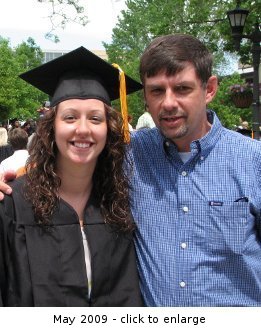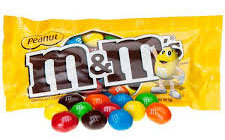The “ALS diet”
 Many of you have admired the photos of my daughter Nicole’s wedding on Facebook. The photographer certainly did a magnificent job. A beautiful bride in a gorgeous dress, a handsome groom and (not all weddings can boast of this) a beautiful officicant might have made his job easier, but he deserves enormous credit for some outstanding work.[1]
Many of you have admired the photos of my daughter Nicole’s wedding on Facebook. The photographer certainly did a magnificent job. A beautiful bride in a gorgeous dress, a handsome groom and (not all weddings can boast of this) a beautiful officicant might have made his job easier, but he deserves enormous credit for some outstanding work.[1]
I personally did not enjoy the photographs of the bloat-faced fellow who walked the bride down the aisle.
Yup, that bloat-faced fellow in the photographs is me. Yikes! If I do any better with this “ALS diet” my eyes will completely disappear. This is to say nothing of the beach ball that I seem to be hiding under my shirt.
 Just what is this “ALS diet” to which I refer? Is it something I’ve dreamed up to excuse my gluttonous appetite?
Just what is this “ALS diet” to which I refer? Is it something I’ve dreamed up to excuse my gluttonous appetite?
I did not dream it up: it is real and it is a great excuse.
It has long been understood that it is very important for ALS patients to maintain body fat. Persons with ALS (PALS) in the “moderately obese” category as measured by body mass index (BMI) live longer and enjoy higher levels of function with the disease. Studies show that this is true across a wide spectrum of disease presentations. Just this year, a new study purports to show that not just high-calorie diets in general, but high-carbohydrate diets in particular are good for PALS.[2] My nutritionist at the VA has consistently encouraged me to keep the weight on and I think I might be considered his “star pupil.”
When I visited a doctor in January 2010 for a physical, I had one specific complaint: a “sports hernia.” I had missed noon basketball for a month because of what felt like a pulled muscle high on my inner thigh. I hoped he would tell me what could be done to expedite the healing of this injury because I was eager to get back on the court. I had two lesser complaints that day. One that I did not think worthy of mention was that I had been having a harder time playing basketball even before the hernia because, I thought, I was out of shape. I tired easily. I suspected that this was due to my being overweight. I weighed between 180 and 185 pounds at the time and thought I needed to get down to about 175.
 As I have recounted before, the other thing I brought up to him that day (at Joann’s urging) was a periodic odd cramping in my left hand. When I told him about it, he observed that there was considerable atrophy of the muscles in that hand and arm (I hadn’t noticed this). He gave me a referral for the electromyography (EMG) that pretty much made me forget about the sports hernia.
As I have recounted before, the other thing I brought up to him that day (at Joann’s urging) was a periodic odd cramping in my left hand. When I told him about it, he observed that there was considerable atrophy of the muscles in that hand and arm (I hadn’t noticed this). He gave me a referral for the electromyography (EMG) that pretty much made me forget about the sports hernia.
Skip forward about a year to February 2011 (the time of my definitive diagnosis) and I weighed 193 pounds, about 10 pounds heavier than my “out-of-shape” weight. This weight gain I attribute primarily to the lack of exercise. I had quit playing basketball entirely, quit riding my bicycle to work and, though I managed to play a season of softball and weekly pickup volleyball, I was not doing anything like “working out.”
By now, my ALS healthcare team was telling me about the benefits of a high-fat, high-calorie diet. I embraced it. Retirement and all of the big juicy hamburgers I could eat seemed like the best perks of the disease. I pretty quickly ballooned to just about 200 pounds and have maintained that weight ever since.
 A weight gain of about 15 pounds since the onset of my symptoms may not seem like much. But it most definitely is. I have lost a lot of muscle. A lot. If muscle weighs more than fat, my weight gain is all the more impressive.
A weight gain of about 15 pounds since the onset of my symptoms may not seem like much. But it most definitely is. I have lost a lot of muscle. A lot. If muscle weighs more than fat, my weight gain is all the more impressive.
I don’t like the way I look. It is jarring to see my bloated face in photographs and I just don’t want to recognize it. Combine it with my “ALS stomach” and I look to be about seven months pregnant (which would be a great excuse, too, but no one will buy that). I keep telling myself this is a good thing. Now that I am struggling mightily to feed myself[3], I do what I can to eat calorie-dense foods. Often. Between meals, my snack food of choice is a healthy one: peanuts wrapped in a layer of carbohydrates that melts in my mouth, not in my hands.
As far as the way I look, I keep in mind it a bit of wisdom written by President Woodrow Wilson:
For beauty I am not a star
There are others more handsome by far
But my face I don’t mind it
For I am behind it
It’s the people in front that I jar
It is okay that it is my weight chart that looks good, not me:
| DATE | TITLE |
| 02/28/2019 | Unhappy Anniversary |
| 05/12/2017 | The Eyes Have It |
| 08/04/2016 | YFALS National Corntoss Challenge |
| 07/18/2016 | Scopolamine Blues |
| 03/06/2016 | Dragon Me Down |
or see the Complete ALS Bites
—
Notes
- See www.jtreynolds.com and on Facebook Jon Reynolds Art & Photography. I can give him the highest recommendation. [^]
- See Weight Loss, Dysphagia and Supplement Intake in Patients With Amyotrophic Lateral Sclerosis (ALS) and High-calorie diet could slow progression of motor neuron disease (ALS), study finds. [^]
- The hamburgers that were such a nice perk are becoming a thing of the past. I can’t feed them to myself and even with help they are difficult to eat. I order a lot of boneless chicken wings when I am out these days. I can still feed myself about half of a serving. When I tire, Joann forks them for me. She feeds me most of the time at home. So far I can’t persuade her to make airplane noises as she moves the fork to my mouth.
At this point my swallowing is close to normal. Choking has not been much of an issue. Atrophy of my tongue is beginning to make it somewhat difficult to chew, but I should not need a feeding tube anytime soon. Maybe in a year. [^]

